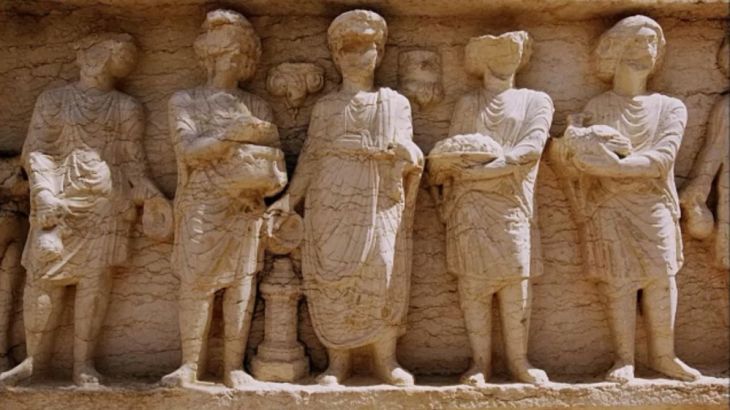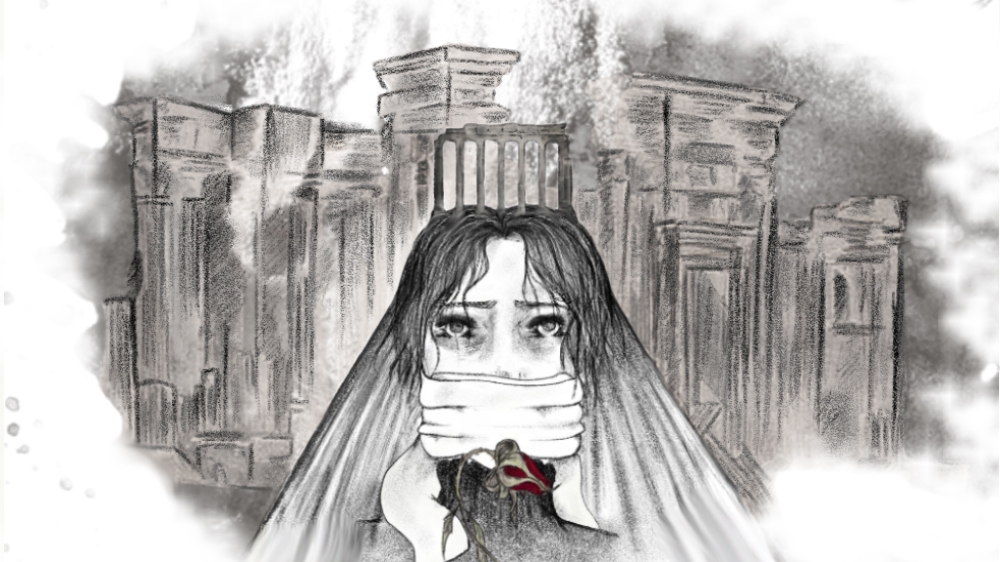
Art Trafficking
We investigate the clandestine world of art and antiquities trafficking.
Filmmaker: Tania Rakhmanova
Antiquities trafficking is one of the most profitable illegal trades in the world. Estimated to be worth several billion dollars a year, it comes in after illegal arms and drug trades.
Keep reading
list of 4 itemsInside the pressures facing Quebec’s billion-dollar maple syrup industry
‘Accepted in both [worlds]’: Indonesia’s Chinese Muslims prepare for Eid
Photos: Mexico, US, Canada mesmerised by rare total solar eclipse
These precious cultural objects have been the “spoils of war” – plundered and sold on. The pillaged nations have demanded their return, but for a long time these demands were largely ignored.
When the Islamic State of Iraq and the Levant (ISIL) group deliberately destroyed cultural heritage sites in Syria and Iraq, it sparked an international outcry and interest in the issue grew.
From Paris to Beijing, this film uncovers the players involved in the antiquities trade – the states, the traffickers, the auction houses, the collectors – as well as those trying to stop it.
At a state level, we discover that a number of priceless artefacts, looted by Western countries during colonial times, have recently been returned to their home countries in a bid to improve diplomatic and economic ties.
Returning pillaged artefacts
One of the stories we investigate centres around a political dispute that erupted between France and China in 2009, after two 18th-century bronze sculptures – one of a rat’s head and the other of a rabbit’s head – were auctioned off at the Christie’s auction house in Paris.
They had been part of the private collections of French fashion designer Yves Saint Laurent and French industrialist Pierre Berge. But both had been looted from China in 1860, when French and British soldiers ransacked China’s imperial summer palace during the Opium Wars.
China considers the bronze heads to be priceless examples of their cultural heritage.
At auction, the looted bronzes sold for a combined $29m to an anonymous telephone bidder, despite protests from Beijing.
But five days later, the mysterious buyer identified himself as a Chinese businessman and refused to pay for the looted bronzes.
The bid was cancelled and the sculptures were returned to Berge.
China continued to demand their return, and in 2013, Christie’s owner Francois Pinault convinced Berge to sell him the artefacts. He then “gifted” them to China.
We need to stigmatise this crime ... Before, there were 'blood diamonds' - now there are 'blood antiquities'.
Officially, Pinault returned the heads to Beijing out of friendship for the people of China. But a few weeks later, the Chinese gave Christie’s permission to operate in the country.
This case was far from unique.
The museums
More and more pillaged countries are demanding the return of their cultural assets, which are often now the trophies of renowned Western museums.
Citing the 1970 UNESCO Convention, which demands that all nations return illegally obtained objects, pillaged countries have a legal tool to negotiate the return of their stolen treasures.
The pressure is intensifying on the museums and private collectors.
The Pergamon Museum, the most visited in Berlin, is obliged to know the origins of its collections.
Its art director Markus Hilgert explains: “As a director, I cannot say ‘I don’t know’ when somebody asks me ‘How did your collection actually come into being?’ So my responsibility as director of this museum is to know everything about the objects.”
On a daily basis, his team meticulously reviews the files for the 500,000 objects in the museum to ensure that they were legally obtained.
The museum stopped acquiring artefacts in the 1930s, 40 years before the signing of the UNESCO Convention, which would seemingly protect it from demands for restitution. But that is not the opinion of Turkey, particularly residents of the city of Gaziantep.
“From Gaziantep alone, 20 or so objects were plundered and we know the museums where they are now,” says Gaziantep mayor Fatma Sahin.
READ MORE – Syria’s Civil War: Aleppo’s heritage sites ‘in danger’
This list includes objects that are on show in the British Museum in London, but also in the Pergamon in Berlin.
Although they were all acquired before 1970, Turkey wants them back.
Like China and Italy, Turkey has made the restitution of its treasures a political priority. Forty or so lawsuits have already been won by Turkey, resulting in the return of more than 4,000 objects.
Private collectors
While pillaged nations such as Turkey have a legal framework to demand restitution from other countries, this doesn’t necessarily apply to the private sector, where only the market seems to rule.
In 1995, the International Institute for the Unification of Private Law (UNIDROIT) Convention on Stolen or Illegally Exported Cultural Objects was introduced in an effort to address this. It obliges sellers to prove the legal origin of an artefact as well as obliging buyers to demand proof.
But although the original UNESCO Convention is recognised by 130 nations, only 37 party states have committed to the UNIDROIT Convention.
The lack of regulation has been exacerbated by the existence of tax-free economic zones. Art dealers are able to use free-port warehouses in these tax-free zones to discreetly store artefacts, sometimes for years.
It’s estimated that there are more than a million works deposited in Geneva’s free port, more than twice the number contained in the Louvre.
These facilities explain why the Phoenix Ancient Art gallery keeps most of its merchandise in free ports. The gallery belongs to Ali Aboutaam, one of the biggest antiquities dealers in the world.
In 2010, customs authorities discovered a second-century Roman sarcophagus in Ali Aboutaam’s warehouse in Geneva.
Since then, it has been at the centre of a complex legal battle.
Aboutaam’s family had owned the sarcophagus for decades, but was unable to provide proof of origin at the time of its sale to the Gandur Foundation. Faced with doubts over the object’s ownership history, the sale was cancelled. Swiss authorities alerted Ankara, which decided to pursue a legal course of action.
“These procedures were launched to try to find out who had exported the object and where the illegal excavation had taken place. It was clearly the product of an illegal dig,” says Marc-Andre Renold, the lawyer representing Turkey.
|
|
In September 2015, a Swiss justice finally ordered the repatriation of the sarcophagus to Turkey. But Aboutaam continues to claim ownership based on a certificate delivered by the Art Loss Register, an organisation that keeps a database of stolen artworks.
For a fee, any buyer or seller can ask the London-based Art Loss Register to sift through more than 400,000 objects in its database to verify that a piece is not listed.
However, it has its limitations because objects discovered in war zones during illegal digs will never be listed.
“The Art Loss certificate only really covers classically looted objects. But in this case, the rightful owner, a state, doesn’t know that it’s the victim of a theft. It doesn’t know how or when the item was discovered or taken,” explains Renold.
The ISIL dimension
With the absence of common legislation and with sky-rocketing prices, trafficking has taken on industrial proportions.
Today, the internet gives looters anonymity and direct access to buyers without the burden of proof of origin or legal documents.
Antiquities trafficking was rarely in the public eye until the world witnessed ISIL’s deliberate destruction of ancient heritage sites in Iraq and Syria.
In 2015, ISIL fighters destroyed the Mosul museum in Iraq and the ancient temples of Baalshamin and Bel in the Syrian city of Palmyra, a UNESCO World Heritage site.
But why is ISIL targeting these historical sites? And to what extent is it also profiting from them?
READ MORE – The blood antiquities funding ISIL
While ISIL has been suspected of partly financing its activities through antiquities trafficking, proving it has been a challenge.
“If we can prove that terrorists are self-financing through antiquities trafficking, it will become a matter of security and not just of culture. And that is what matters,” explains France Desmarais, of the International Council of Museums (ICOM).
Each year, ICOM publishes a list of rare objects from various countries which threaten to turn up on the international art market. This time, it listed antiquities from Iraq and Syria, suspected of financing ISIL operations.
The Strasbourg-based Association for the Protection of Syrian Archaeology (APSA) has been recording cases of plundering in Syria since the outbreak of the war.

Its head, Syrian archaeologist Cheikhmous Ali, says ISIL isn’t the only armed group plundering sites in Syria: “All military groups active on Syrian soil are involved, but people talk only of Daesh [ISIL] because they display their savage acts in Hollywood-style productions.”
Based on his research, Ali says he believes that “an armed group won’t sell an ancient coin to finance its arms purchases. It’s not easy to sell objects, you need to find the right channels and the right collector. You have to meet the collector to prove authenticity. Then, you have to smuggle them safely into neighbouring countries. The profits aren’t huge. Especially when there’s oil, which they can sell immediately and take the money and run”.
Other famous stolen artefacts
Among the thousands of artefacts from around the world that have been stolen or traded in dubious ways, there are a few that are particularly well known.
It has been 200 years since the Greek Parthenon marbles were taken from Athens by a Scottish lord and sold to the British government. They now sit in the British Museum. But the Greeks say they were removed illegally and should be returned.
Then there is Egypt’s Rosetta Stone, discovered by a Frenchman and later acquired by the British, as well as its bust of Queen Nefertiti, discovered by a German archaeologist, which now sits in a Berlin museum.
The Egyptian government wants both pieces returned.
Other disputed artefacts include the Indian Koh-i-Noor diamond, one of the largest in the world. It was taken by Britain’s East India Company and presented to Queen Victoria.